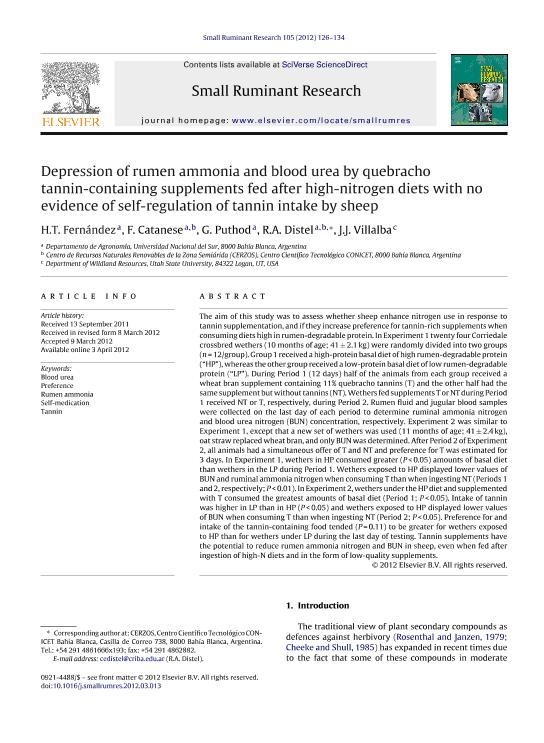Artículo
Depression of rumen ammonia and blood urea by quebracho tannin-containing supplements fed after high-nitrogen diets with no evidence of self-regulation of tannin intake by sheep
Fernández, Hebe; Catanese, Francisco Hernan ; Puthod, Gaston; Distel, Roberto Alejandro
; Puthod, Gaston; Distel, Roberto Alejandro ; Villalba, Juan José
; Villalba, Juan José
 ; Puthod, Gaston; Distel, Roberto Alejandro
; Puthod, Gaston; Distel, Roberto Alejandro ; Villalba, Juan José
; Villalba, Juan José
Fecha de publicación:
06/2012
Editorial:
Elsevier Science
Revista:
Journal of Small Ruminant Research
ISSN:
0921-4488
Idioma:
Inglés
Tipo de recurso:
Artículo publicado
Clasificación temática:
Resumen
The aim of this study was to assess whether sheep enhance nitrogen use in response to tannin supplementation, and if they increase preference for tannin-rich supplements when consuming diets high in rumen-degradable protein. In Experiment 1 twenty four Corriedale crossbred wethers (10 months of age; 41 ± 2.1. kg) were randomly divided into two groups (n= 12/group). Group 1 received a high-protein basal diet of high rumen-degradable protein (" HP" ), whereas the other group received a low-protein basal diet of low rumen-degradable protein (" LP" ). During Period 1 (12 days) half of the animals from each group received a wheat bran supplement containing 11% quebracho tannins (T) and the other half had the same supplement but without tannins (NT). Wethers fed supplements T or NT during Period 1 received NT or T, respectively, during Period 2. Rumen fluid and jugular blood samples were collected on the last day of each period to determine ruminal ammonia nitrogen and blood urea nitrogen (BUN) concentration, respectively. Experiment 2 was similar to Experiment 1, except that a new set of wethers was used (11 months of age; 41 ± 2.4. kg), oat straw replaced wheat bran, and only BUN was determined. After Period 2 of Experiment 2, all animals had a simultaneous offer of T and NT and preference for T was estimated for 3 days. In Experiment 1, wethers in HP consumed greater (P< 0.05) amounts of basal diet than wethers in the LP during Period 1. Wethers exposed to HP displayed lower values of BUN and ruminal ammonia nitrogen when consuming T than when ingesting NT (Periods 1 and 2, respectively; P< 0.01). In Experiment 2, wethers under the HP diet and supplemented with T consumed the greatest amounts of basal diet (Period 1; P< 0.05). Intake of tannin was higher in LP than in HP (P< 0.05) and wethers exposed to HP displayed lower values of BUN when consuming T than when ingesting NT (Period 2; P< 0.05). Preference for and intake of the tannin-containing food tended (P= 0.11) to be greater for wethers exposed to HP than for wethers under LP during the last day of testing. Tannin supplements have the potential to reduce rumen ammonia nitrogen and BUN in sheep, even when fed after ingestion of high-N diets and in the form of low-quality supplements.
Palabras clave:
Blood Urea
,
Preference
,
Rumen Ammonia
,
Self-Medication
,
Tannin
Archivos asociados
Licencia
Identificadores
Colecciones
Articulos(CERZOS)
Articulos de CENTRO REC.NAT.RENOVABLES DE ZONA SEMIARIDA(I)
Articulos de CENTRO REC.NAT.RENOVABLES DE ZONA SEMIARIDA(I)
Citación
Fernández, Hebe; Catanese, Francisco Hernan; Puthod, Gaston; Distel, Roberto Alejandro; Villalba, Juan José; Depression of rumen ammonia and blood urea by quebracho tannin-containing supplements fed after high-nitrogen diets with no evidence of self-regulation of tannin intake by sheep; Elsevier Science; Journal of Small Ruminant Research; 105; 1-3; 6-2012; 126-134
Compartir
Altmétricas



